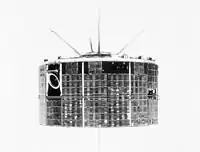 TIROS-9 satellite | |
| Mission type | Weather satellite |
|---|---|
| Operator | NASA |
| COSPAR ID | 1965-004A |
| SATCAT no. | 978 |
| Spacecraft properties | |
| Spacecraft type | TIROS |
| Manufacturer | RCA / GSFC |
| Launch mass | 138.30 kilograms (304.9 lb)[1] |
| Dimensions | 1.07 m × 0.56 m (3.5 ft × 1.8 ft) |
| Start of mission | |
| Launch date | January 22, 1965, 07:52 UTC[2] |
| Rocket | Thor-Delta C 374/D-28 |
| Launch site | Cape Canaveral LC-17A |
| End of mission | |
| Last contact | February 15, 1967 |
| Orbital parameters | |
| Reference system | Geocentric |
| Regime | Low Earth |
| Eccentricity | 0.11693[1] |
| Perigee altitude | 705 kilometers (438 mi)[1] |
| Apogee altitude | 2,582 kilometers (1,604 mi)[1] |
| Inclination | 96.43°[1] |
| Period | 119.23 minutes[1] |
| Epoch | January 22, 1965[1] |
| Instruments | |
| Television Camera System | |
TIROS-9 (also called TIROS-I or A-54) was a spin-stabilized meteorological satellite. It was the ninth in a series of Television Infrared Observation Satellites.
Launch
TIROS-9 was launched on January 22, 1965, by a Thor-Delta rocket from Cape Canaveral Air Force Station, Florida. The spacecraft functioned nominally until February 15, 1967. The satellite orbited the Earth once every 2 hours, at an inclination of 96°. Its perigee was 705 kilometers (438 mi) and apogee was 2,582 kilometers (1,604 mi).[1]
Mission
TIROS-9 was a spin-stabilized meteorological spacecraft designed to test experimental television techniques and infrared equipment. The satellite was in the form of an 18-sided right prism, 107 cm in diameter and 56 cm high. The top and sides of the spacecraft were covered with approximately 9000 1-by 2-cm silicon solar cells. It was equipped with 2 independent television camera subsystems for taking cloudcover pictures, plus an omnidirectional radiometer and a five-channel scanning radiometer for measuring radiation from the earth and its atmosphere. The satellite spin rate was maintained between 8 and 12 rpm by use of five diametrically opposed pairs of small, solid-fuel thrusters.
The TV system operated normally until April 1, 1965, when one of the wide-angle TV cameras failed. The other camera operated normally until July 26, 1965, and sporadically until February 15, 1967. TIROS 9 was the first satellite in the TIROS series to be placed in a near-polar orbit, thereby increasing TV coverage to the entire daylight portion of the Earth.[3]
References
- 1 2 3 4 5 6 7 8 "TIROS 9". National Space Science Data Center Master Catalog. NASA Goddard Space Flight Center. Retrieved June 4, 2018.
- ↑ McDowell, Jonathan. "Launch Log". Jonathan's Space Page. Retrieved June 4, 2018.
- ↑ "TIROS 9 (1965-004A)". NASA Goddard Space Flight Center. Retrieved June 4, 2018.
 This article incorporates text from this source, which is in the public domain.
This article incorporates text from this source, which is in the public domain.
External links
- Real Time Satellite Tracking - TIROS 9. N2yo.com
- Technical Summary of Polar Meteorological Satellites. pdf
